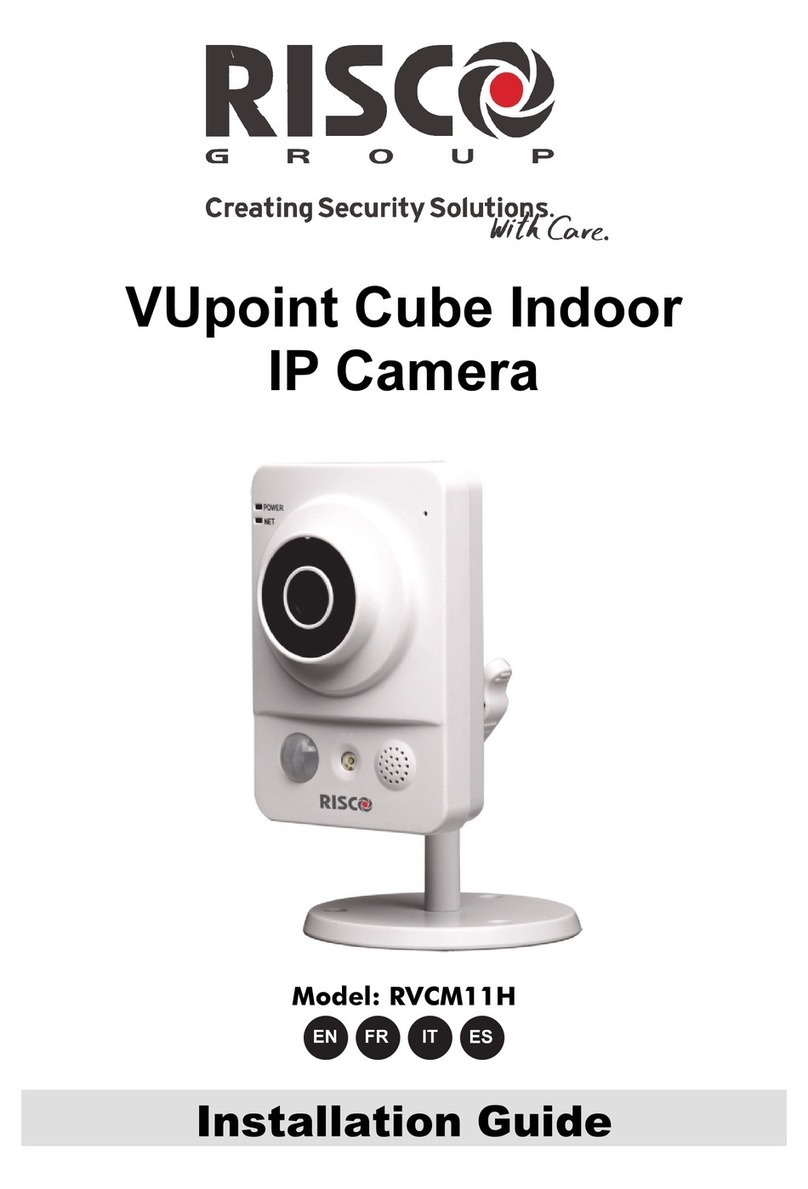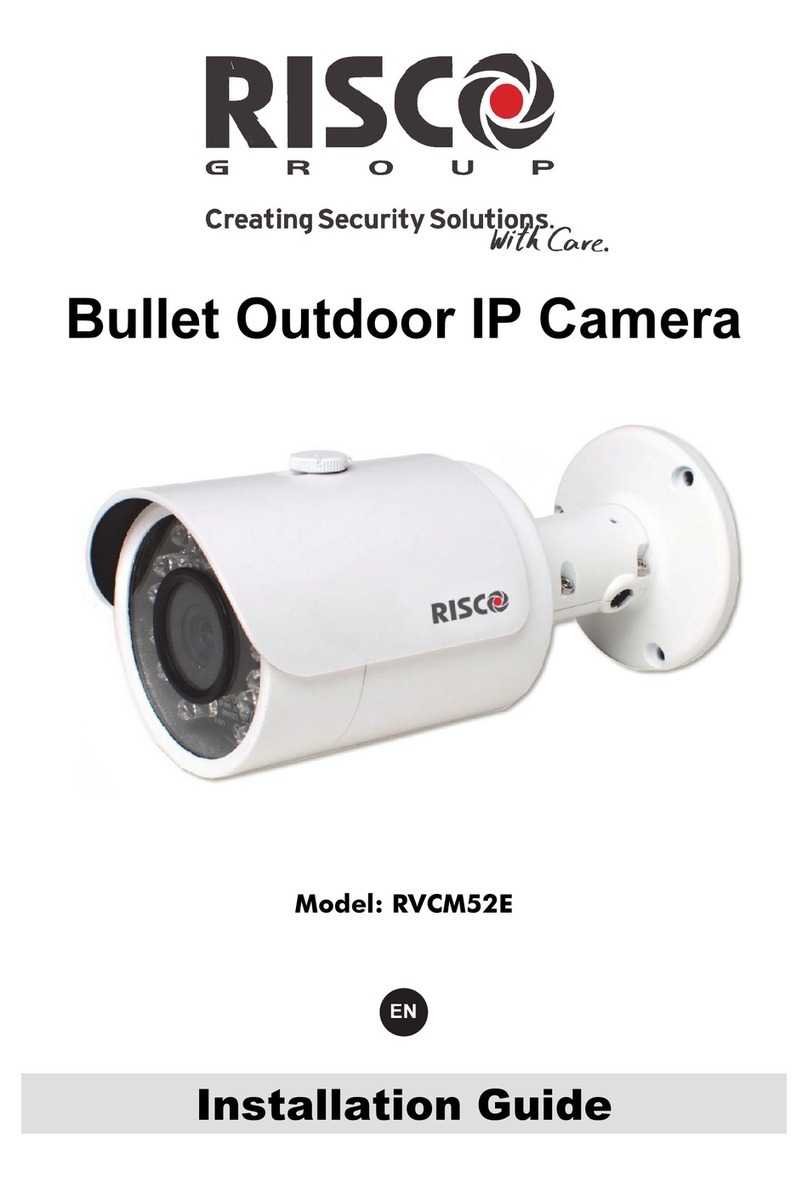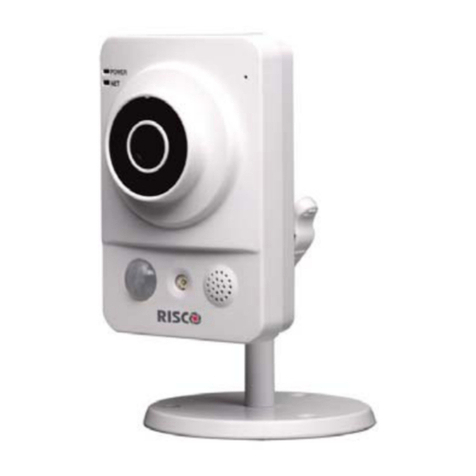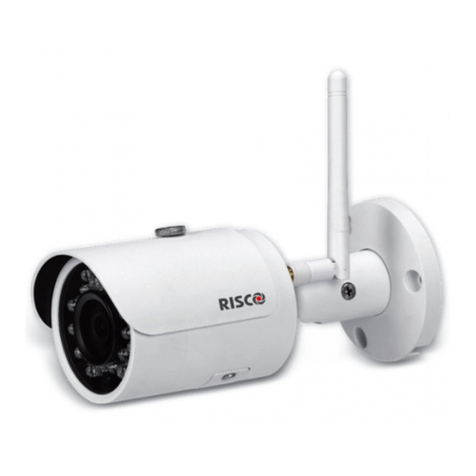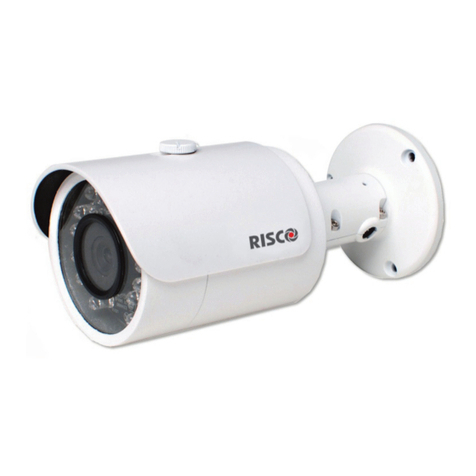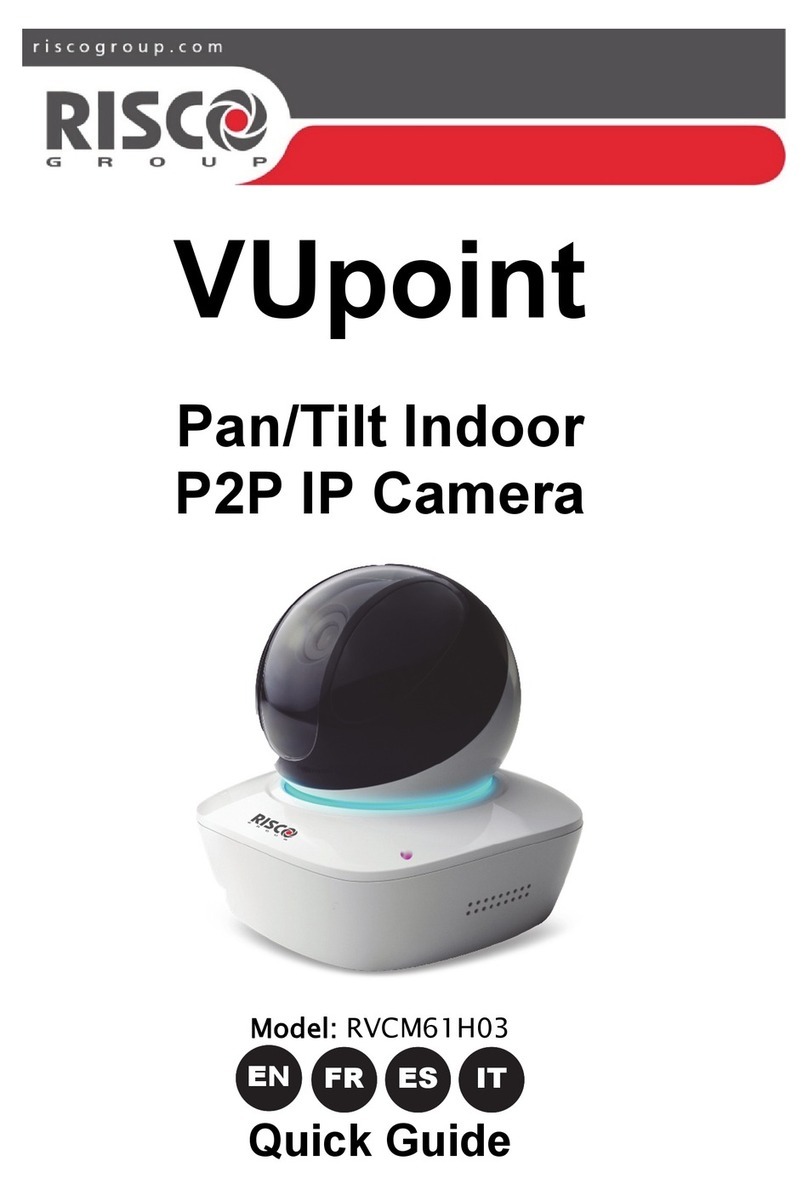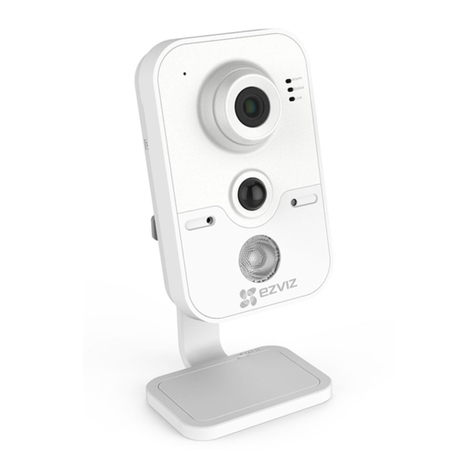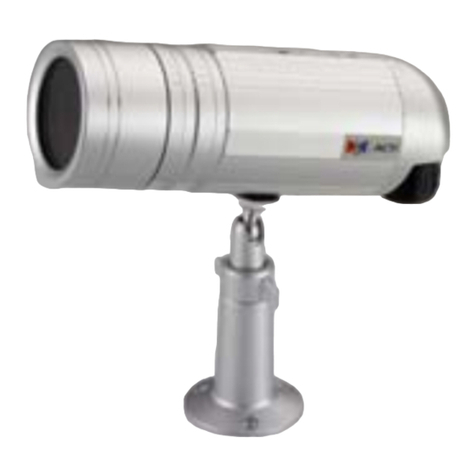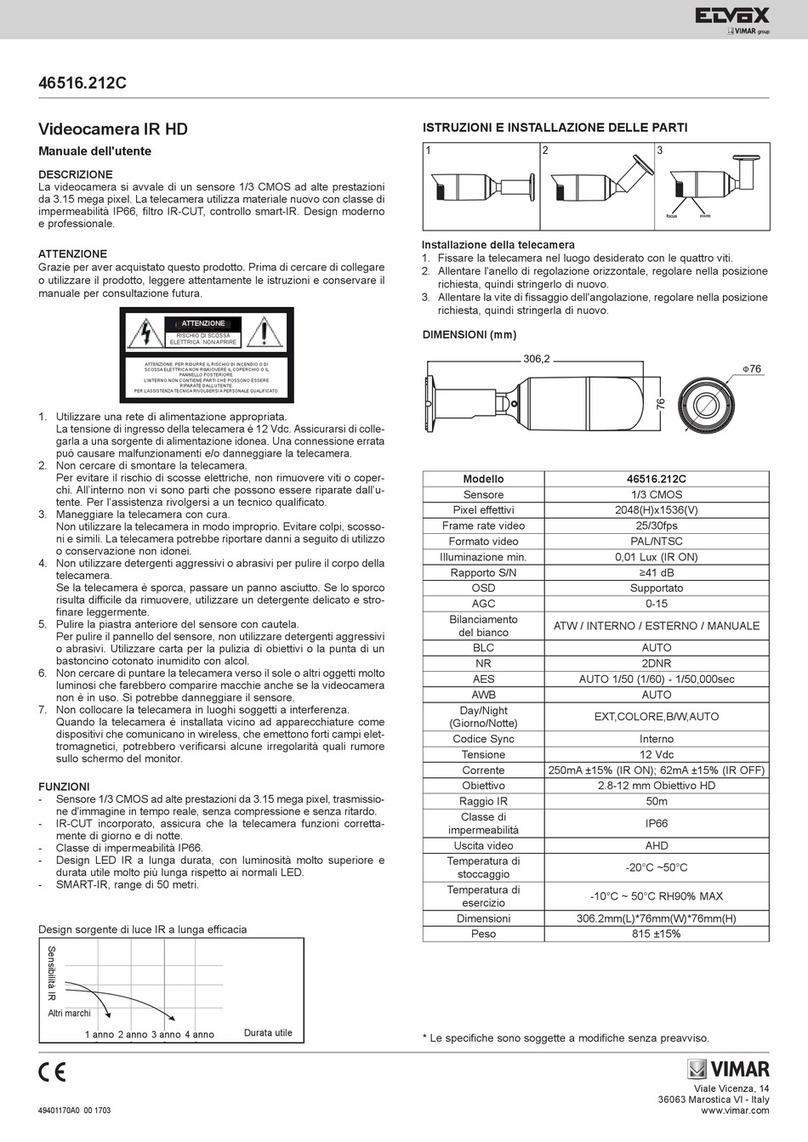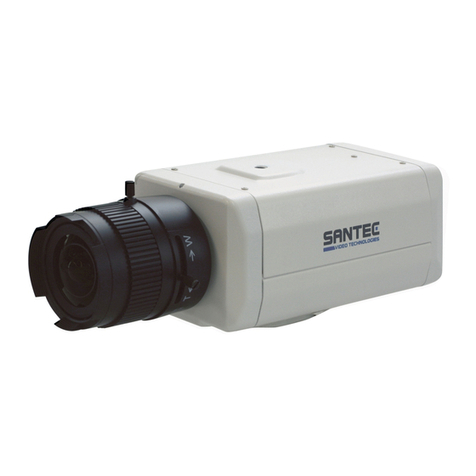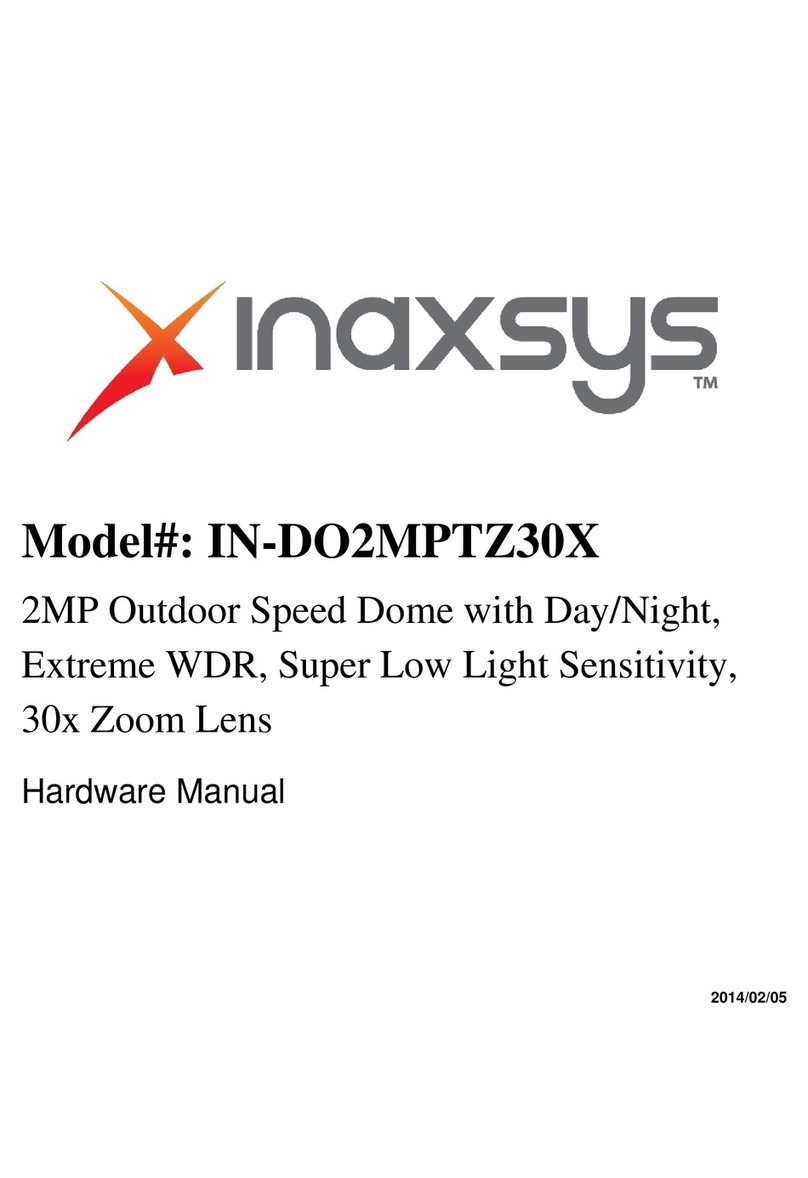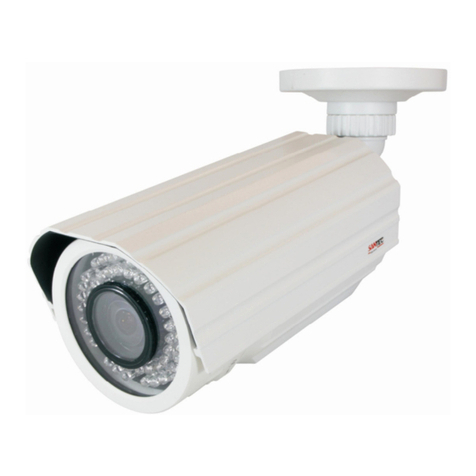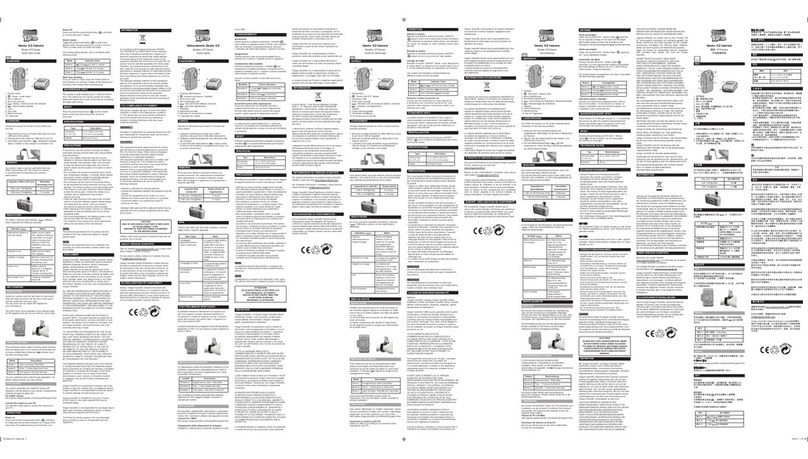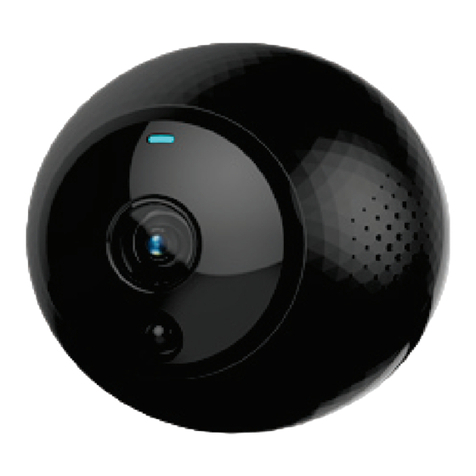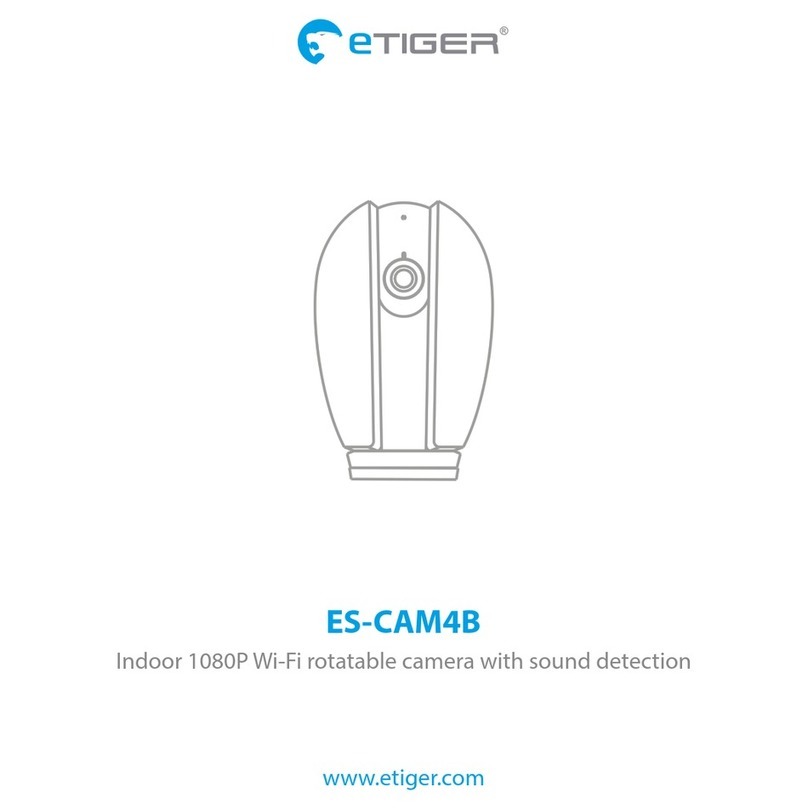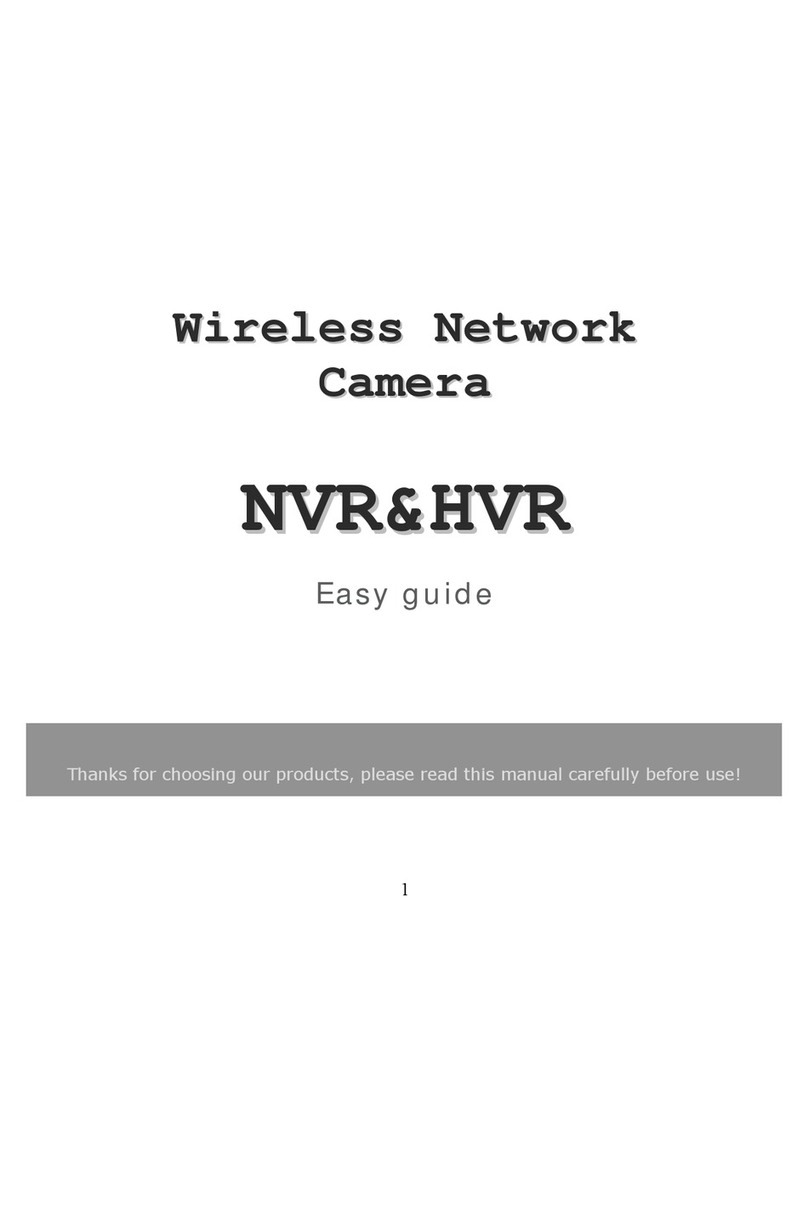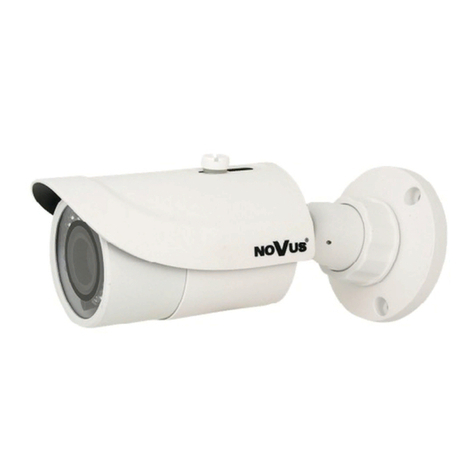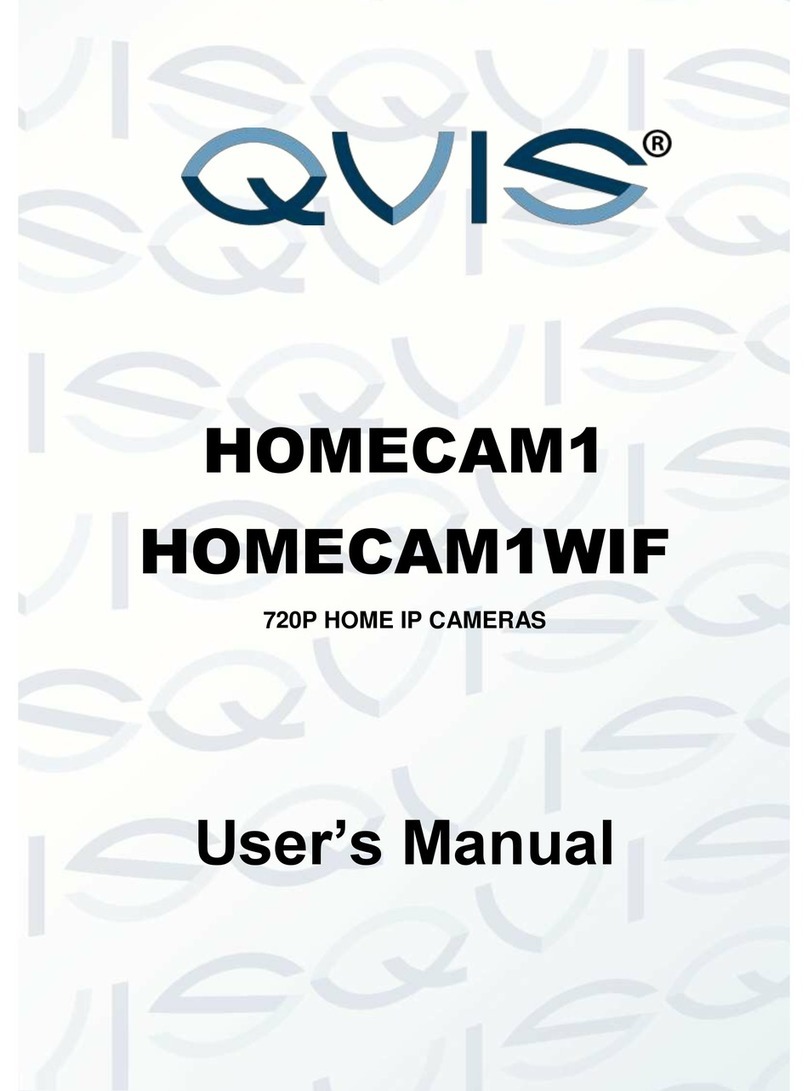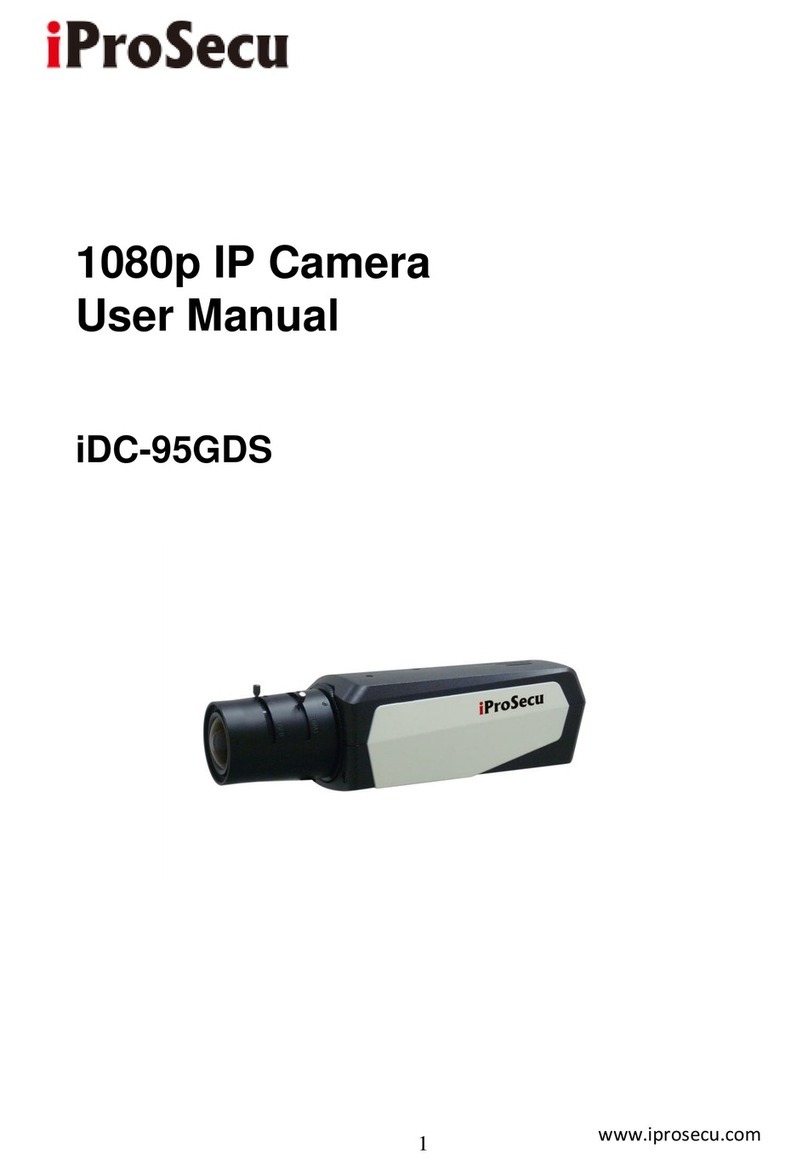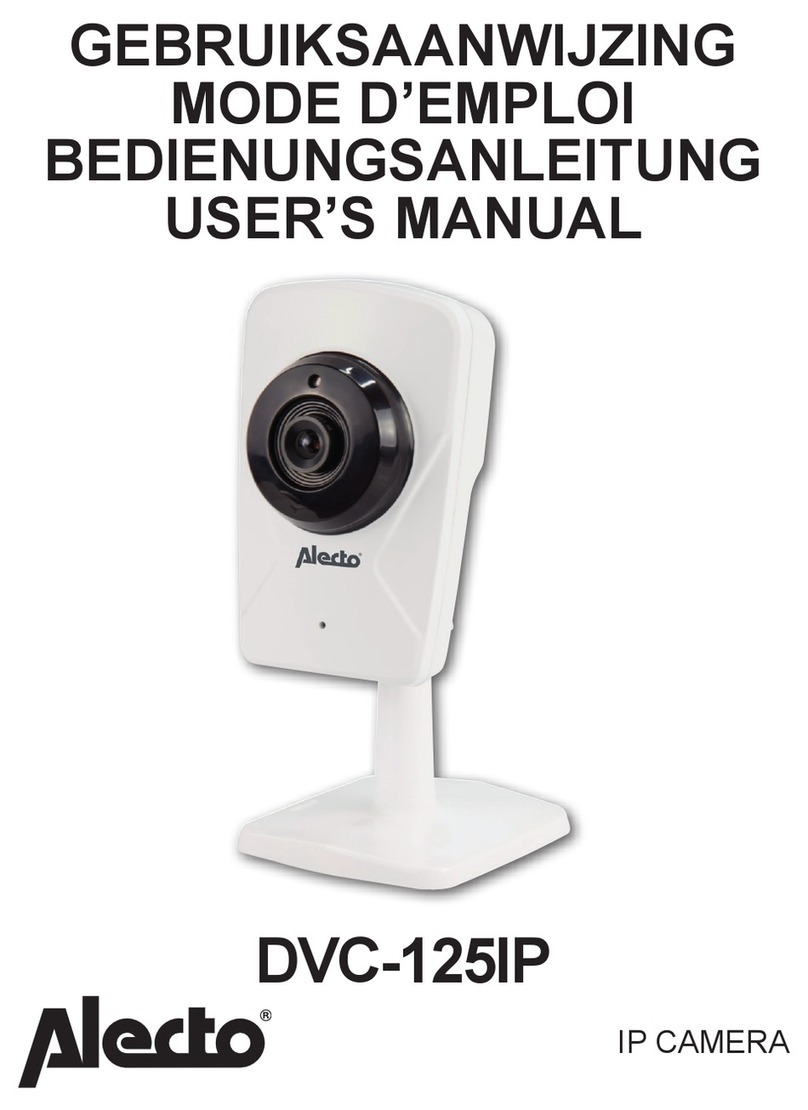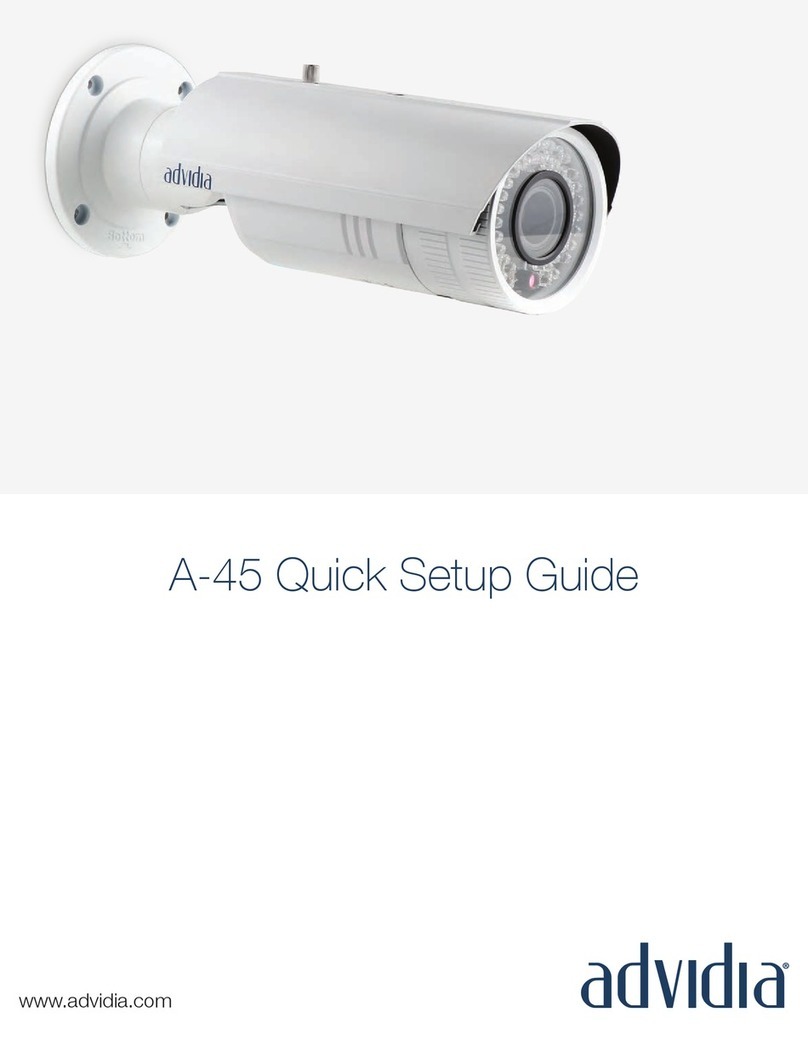Risco eyeWAVE RWX95CM User manual

eyeWAVE™ Wireless
PIR Camera
Models: RWX95CM/RWX95CMP
EN FR IT ES
Installation Instructions
EN
Description
The eyeWAVE™ Wireless PIR Camera Detector is a
battery powered PIR detector that includes an
inte rated camera for visual verification and is
compatible with RISCO security systems.
Features include:
•
PIR covera e 12m (40’) wide an le
•
VGA or QVGA camera resolution with ~85° field-of-
view
•
Discreet IR flash allows ima in in complete
darkness, up to 10m (33’)
•
Sequence of ima es upon event, confi urable
number and fps
•
Durin disarm, events are i nored to save battery
and for privacy
•
On-demand ima es initiated from authorized
Smartphone or web browser
•
Two RF channels with separate antennas: One for
control, second channel for ima e transmission
•
Ima es stored on detector until transmission to
panel complete
•
Includes 2 lon -life 3V lithium batteries
Installation
Step1: Preliminary Considerations
Select the mountin location for best covera e of the
area that is to be protected (see Coverage Patterns and
Preliminary Considerations).
Step 2: Registering the Detector into
the System
The eyeWAVE must identify itself to the system receiver
in a device allocation (enrollment) process, which can be
performed by either RF sequence re isterin or enterin
the detector’s 11-di it serial number into the system or
usin RF mode panel quick key pro rammin
Sequence:
From the panel: 2) Radio Devices > 1) Allocation > 1) By
RF or 2) By Code.
Through the Configuration Software: Click Radio
Device Allocation > Enter Serial Code: [045] + [8 di its];
Indexed: Automatic or manually desi nated 1-32;
Accessory Type: 2-Way Detector (displayed)). Then
click Allocate: RF Allocation is performed.
For more information refer to the System Installer Manual.
Step 3: Mounting the Detector
1. Open the knockout holes of the mountin
bracket, and use them as a template for mountin
(see Figure 3).
For Pet friendly model:
In order to optimize pet immunity the followin uide
lines are recommended:
Mount the detector vertically at ri ht an les to the floor.
Make sure an animal cannot et above hei ht of 1.5m
(5') by climbin on furniture, shelvin or stairs.
2. Fasten the cover to the base of the detector by
insertin and fastenin screw into the hole
located inside the battery compartment (see Figure
2)
3. Insert the batteries and close the battery
compartment cover (see Figure 2)
4. Once the bracket is installed, slide and lock the
detector onto the mountin bracket in reverse
sequence (see Figure 4)
5. Perform a Walk Test as described in the Walk
Test section (see Figure 5).
6. Insert and fasten screw (C) into the hole located
at the bottom of the detector to lock the detector
to the mountin bracket (see Figure 4).
Step 4: Performing a Walk Test
Upon insertin the batteries, the detector oes into a
Walk Test mode for 20 minutes and then automatically
returns to Normal mode (to save battery power). Durin
Walk Test Mode, the detector transmits a si nal, after
each detection. Walk test the entire field of view of the
detector and observe the LED for confirmation. Verify
that the receiver is properly receivin the si nals.
To manually initiate a walk test from the control panel:
Installation Menu: 2) Testin > 2) Zone > 3) Walk Test 1)
Start Walk Test. The detector remains in walk test mode
until any key on the panel is pressed. Display test
results as follows: Installation Menu: 2) Testin > 2)
Zone > 3) Walk Test 2) Walk Test Results
Camera Configuration
Bein bi-directional, the detectors parameters can be
modified from the keypad or from the system
confi uration software accordin to your needs
PIR
Sensitivity:
Hi h/Low (Default: Low)
Supervision
Time:
0-255 minutes (Default: 15 min)
LE : On/Off (Default: On)
Operation
Mode:
Walk Test: The detector will
transmit after each detection
Normal (Default)
For more information refer to the System Installer Manual.
Confi ure the camera settin s throu h the RISCO
Confi uration Software (ri ht-click on the Serial Code
field in the Zones node screen and in the displayed pop-
up click Additional..) or throu h the panel quick key
pro rammin sequence as follows (default in bold):
Pro rammin > 2) Radio Devices > 2) Modification > 1)
Zone [Select (1–32)] >
1) Parameters > 6) Advanced 5) Camera Parameters:
Images at
Alarm:
3 (1 to 7 ima es)
Image Interval: 0.5 sec (0.5, 1, 2 seconds)
Pre-Alarm
Image:
Yes (Yes, No) (Ima e capture
upon each arm)
Image
Resolution:
QVGA (QVGA 320X240, VGA
640X480)
Image Quality: Hi h (Hi h, Low)
Colour Image: Colour (Colour, B&W)
Image upon request
Snapshot ima es can be taken usin web/smartphone
apps (on panels supportin these applications).
Event Reporting
Every event detected by the PIR camera is recorded into
the camera’s memory. The event record consists of the
date and time mark, detail description of the event
includin its source and a video record.
LED Status
On: Alarm
Blinking twice (in alarm mode): Low battery
Blinking four times (in initial
learning mode)
Successful
write
operation
Diagnostics
You can perform dia nostic tests on your detector usin
the keypad or the confi uration software. Dia nostics
includes testin the detector battery status and the
communication between the detector and the panel.
For additional information refer to the System Installer
Manual.
To replace the batteries:
1. Remove the detector from the mountin bracket
(see Figure ).
2. Open the battery cover (see Figure 2).
3. Replace the batteries. Pay attention to the ri ht
polarity.
4. Close the battery cover.
CAUTION – Risk of explosion if battery is replaced by
an incorrect type. Dispose of used batteries accordin to
local re ulations.
NOTE – After replacin the batteries and closin the
tamper, the detector will automatically o into in Walk
Test mode for 20 minutes.
Specifications
Electrical
Battery Type: 2 x CR 123, 3V Lithium Battery
Battery Life: 2 batteries – 3 year typical
lifetime
Current
Consumption:
58 µA standby;
200 mA max. peak at capture
with flash
Supervision
Transmission:
0-255 minutes
RF
transmitting
frequencies:
868.65 MHz; 869.525 MHz for
model RWX95CM8
433.92 MHz; 916 MHz for
model RWX95CM4
Optical
Filtering: White Li ht Protection
Pet friendly: Up to a 36 k (80lb) animal (pet
model)
Physical
Size: 132 x 67,5 x 56 mm (5.1 x 2.6 x
2.2 in)
Weight: 169 rams (5.96 oz.)
Environmental
RF Immunity: Accordin to EN50130-4
Operating
Temperature:
-10°C a 55°C (14°F a 140°F)
Storage
Temperature:
-20°C a 60°C (-4°F a 140°F)
Camera
Type: CMOS di ital ima e sensor
Lux: 0 Lux (total darkness)
View Angle: H 90 o V 71o
FR
Description
L’eyeWave™ sans fil est un détecteur IRP alimenté par
piles, avec un appareil photo inté ré, conçu pour la
levée de doute visuelle d’alarme et une installation
simple par les installateurs d’alarme. L’appareil photo
capture et transmet une séquence d’ima es à un serveur
distant ou à un téléphone portable via les systèmes
RISCO, sur occurrence d’un évènement d’intrusion ou à
la demande de l’utilisateur.
•
Couverture IRP 12m rand an le
•
Résolution photo VGA/VGA avec champ de vision
d’environ~90°
•
Flash IR discret qui permet la prise d’ima e dans le
noir complet jusqu’à 10m
•
2 canaux RF avec antennes séparées :
•
Une pour l’alarme et le contrôle, la seconde pour la
transmission d’ima es
•
Séquence d’ima es sur évènement d’alarme : nombre
d’ima es et intervalle confi urables
•
Au désarmement, les évènements sont i norés pour
économiser les piles et pour la vie privée
•
Ima es sur demande initiée par un utilisateur autorisé
via navi ateur Web ou Smartphone
•
Option pour prise d’ima e à l’armement
•
Les ima es sont enre istrées dans le détecteur jusqu’à
la fin de la transmission à la centrale
•
Inclus 2 piles lithium 3V lon ue durée
•
Ne fonctionne qu’avec les systèmes supportant la
Levée de doute visuelle
•
Sécurité contre la fraude : ouverture, arrachement,
champ ma nétique
Installation
Etape 1 : Considérations préliminaires
Choisir l’emplacement de monta e pour obtenir la
meilleure couverture de la zone à proté er (cf. modèles
de couverture).
Attention aux éléments suivants :
Ne pas toucher la lentille avec vos doi ts, cela rendrait
la capture d’ima e floue.
Ne pas monter le détecteur en face de rayons directs du
soleil, ou près d’une source de chauffa e ou d’objets
métalliques.
Les secteurs de détection devraient être orientés en
direction du mur, et non en direction d’une fenêtre ou
de volets.
Choisir la hauteur de monta e selon le modèle de
couverture (nous recommandons une hauteur de 2m à
2.40 m, à au moins 40 cm du plafond).
Etape 2 : Adresser le détecteur dans le
système
L’eyeWAVE doit être identifié au récepteur du système
via un processus d’adressa e, qui peut être réalisé par
un adressa e RF ou en entrant les 11 di its du numéro
de série dans le système, ou par adressa e RF rapide :
Touches rapides depuis la centrale: 1)Pro rammation >
2)Périph.radio > 1)Adressa e > 1)Adressa e RF ou 2)Par
N° Série.
epuis le logiciel de Configuration: Cliquer sur
Adressa e de matériel sans fil > Entrez le n° de série :
[045] + [8 di its] ; Indexe : Automatique ou
manuellement de 1 à 32 ; Type d’accessoire : Détecteur
2Way (affiché). Cliquer alors sur Adresser: L’adressa e
RF est effectué.
Se référer au Manuel d’Installation de l’système pour
des instructions complètes.
Etape 3 : Monter le détecteur
1. Ouvrir les trous pré-percés du support de
monta e, et les utiliser comme modèle pour le
monta e (voir Figure 3).
Pour les modèles avec immunité aux animaux :
Afin d’optimiser l’immunité aux animaux, voici les
recommandations à suivre :
Monter le détecteur verticalement avec un an le droit
par rapport au sol.
S’assurer qu’un animal ne peut pas monter au-dessus
d’1.5m en montant sur des meubles, rayonna es ou
escaliers.
2. Fixer le couvercle à la base du détecteur en
insérant et serrant la vis de fixation dans le trou
situé dans le compartiment des piles (voir Fi ure
2).
3. Insérer les piles et fermer le couvercle du
compartiment des piles (voir Fi ure 2)
4. Une fois que le support est installé, lisser et
verrouiller le détecteur sur le support de
monta e en séquence inverse (voir Fi ure 4)
5. Faire un test de marche comme décrit dans la
section Test de Marche (voir Fi ure 5)
6. Insérer et serrer la vis dans le trou situé sous le
détecteur pour fixer le détecteur au support de
monta e (voir Fi ure 4).
Etape 4 : Test de Marche
Après avoir inséré les piles, le détecteur est en test de
marche pendant 2 minutes, et il retourne ensuite
automatiquement en mode Normal (pour économiser
les piles). Pendant le test de marche, le détecteur
transmettra après chaque détection. Tester le champ de
vision complet du détecteur et observer la LED pour
confirmation. Vérifier que le récepteur reçoit bien les
si naux.
Lancer un test de marche manuellement depuis la
centrale :
Menu installateur : 2)Tests Système > 2)Zone > 3)Test
Marche > 1)Démarrer Test
Le détecteur reste en test de marche jusqu’à ce qu’une
touche soit pressée. Afficher les résultats du test comme
suit :
Menu installateur : 2)Tests Système > 2)Zone > 3)Test
Marche > 2) Résultat Test
Configuration de l’Appareil Photos
Comme il est bidirectionnel, les paramètres du détecteur
peuvent être modifiés depuis le clavier ou le lo iciel de
confi uration du système selon vos besoins :
Sensibilité IRP: Elevée/Faible (Par défaut :
Faible)
Tempo de
supervision
(Supervision TX):
0-255 minutes (Par défaut :
15 min)
LE : On/Off (Par défaut : On)
Mode de détection: Test: Le détecteur
transmettra après chaque
détection
Normal (Par défaut)
Pour plus d’informations, voir le Manuel d’Installation
de l’système.
Confi urer les paramètres de l’appareil photo depuis le
lo iciel de confi uration RISCO (clique droit sur le
champ N° de Série d’ans l’écran Zones, Options…), ou
depuis le clavier de la centrale par les séquences de
touches rapides suivantes (paramètres par défaut en
gras) :
1)Pro rammation > 1)Périph. Radio > 2)Modification >
1)Paramètres > Zone [Sélectionner (1–32)] > 6) Avancé >
5) Param. Photos :
Images par Alarme : 3 (1 à 7 ima es)
Intervalle Image : 0.5 sec (0.5, 1, 2 secondes)
Image Pré-Alarme : Oui (Oui, Non) (Ima es
captures à chaque
armement)
Résolution Image : QVGA (QVGA 320X240,
VGA 640X480)
Qualité Image : Elevée (Elevée, Faible)
Couleur Image : Couleur (Couleur, Noir &
Blanc)
Image sur demande utilisateur
Les ima es peuvent aussi être prises en utilisant les
applications web/smartphone (sur les centrales
supportant ces applications).
Rapport d’évènements
Chaque évènement détecté par le PIR Cam est enre istré
dans la mémoire du PIR Cam jusqu’à transmission.
L’enre istrement de l’évènement est constitué de la date
et l’heure, de la description complète de l’évènement sa
source et un enre istrement d’ima e.
Statut LED
On: Alarme
2 clignotements : (en mode alarme) Batterie
basse
4 clignotements : (en mode d’adressa e
initial) Opération d’écriture
réalisée avec succès
Diagnostiques
Il est possible de réaliser des dia nostiques sur le
détecteur en utilisant le clavier de ou le lo iciel de
confi uration. Les dia nostiques comportent l’état de la
pile du détecteur et la communication entre le détecteur
et la centrale.
Pour plus d’informations, se référer au Manuel
d’Installation de l’système.
Remplacement des piles
Une condition de batterie basse est détectée par une
LED cli notante à chaque transmission.
Pour remplacer les piles :
1. Enlever le détecteur du support de monta e (voir
Figure ).
2. Ouvrir le couvercle des piles (voir Figure 2).
3. Remplacer les piles. Attention à la polarité.
4. Fermer le couvercle des piles.
ATTENTION: Risque d’explosion si les piles sont
remplacées par un type de pile incorrect. Jetez les piles
usa ées selon la ré lementation locale.
NOTE: Après avoir remplacé les piles et fermé
l'autoprotection, le détecteur sera automatiquement en
mode Test de Marche pour une durée de 20 minutes.
Spécifications
Electriques
Type de
batterie :
2 x CR 123, Pile Lithium3V
Batterie Basse 2.6V
urée de vie des
piles : 2 piles - 3 ans typique
Consommation
de courant :
58 µA en veille;
200 mA max. (en capture avec
flash)
Transmission de
supervision :
0-255 minutes0
Fréquences de
transmissions
RF :
868.65 MHz; 869.525 MHz
pour modèle RWX95CM8
433.92 MHz; 916 MHz pour
modèle RWX95CM4
Optique
Filtrage : Protection contre la lumière
blanche
Immunité aux
animaux :
Animal jusqu’à 36 k (modèle
PET)
Physique
Taille : 132 x 67,5 x 56 mm
Poid : 169 rammes
Environnement
Immunité RF : Répond à la norme EN50130-4
Température
d’exploitation :
-10°C à 55°C
Température de
stockage :
-20°C à 60°C
Indice de
Protection (IP)
IP31 IK 04
Appareil Photo
Type : Capteur d’ima e numérique
CMOS
Lux : 0 Lux (obscurité complète)
Angle de vue : H 90 o V 71o
Or anisme de certification
AFNOR CERTIFICATION: 11 rue Francis de Pressensé
93571 LA PLAINE SAINT-DENIS Cedex,
http://www.marque-nf.com
CNPP Cert: BP 2265, 27950 ST MARCEL,
http://www.cnpp.com
Certificate number for RWX95CM: 2622000016A0
Certificate number for RWX95CMP: 2622000016B0
Ce produit répond aux exi ences du référentiel de
certification NF324-H58 pour la classification 2
boucliers, et de la RTC 50131-2-2.
IT
Descrizione
EyeWave™ radio è un rivelatore di movimento
all’infrarosso passivo (PIR) che inte ra una fotocamera.
EyeWave™ è alimentato tramite batterie e viene usato
per la verifica video de li eventi con i sistemi RISCO
compatibili.
•
Copertura PIR di 12m randan olo
•
Risoluzione fotocamera VGA/VGA con campo visivo
di 90°
•
Illuminatore IR che permette di scattare imma ini
nella completa oscurità fino ad una distanza massima
di 10m
•
Due canali radio RF con antenne separate: uno per li
allarmi e la pro rammazione e l’altro per la
trasmissione delle imma ini
•
Sequenza imma ini per evento con numero di
imma ini ed intervallo tra due imma ini
pro rammabile.
•
Durante lo stato di disinserimento li eventi ven ono
i norati al fine di preservare la carica delle batterie e la
privacy
•
A richiesta trasmette imma ini a smartphone e web
browser autorizzati
•
Opzione per lo scatto e la memorizzazione di
un’imma ine all’inserimento del sistema (pre-allarme)
•
Le imma ini ven ono re istrate nel rivelatore fino alla
loro trasmissione completa
•
Include 2 batterie al litio 3 Volt
Installazione
Fase 1: Considerazioni preliminari
Sce liere la posizione di installazione per una buona
copertura dell’area da prote ere (vedere dia rammi di
copertura). Fare attenzione a quanto se ue:
•
Non toccare le lenti con le dita altrimenti le imma ini
non saranno nitide.
•
Non installare il rivelatore in condizioni di luce solare
diretta o vicino a caloriferi e o etti metallici.
•
Il rivelatore dovrebbe essere posizionato di fronte a
mura o pavimento e non di fronte a finestre e tende.
•
Sce liere l’altezza di installazione in funzione dei
dia rammi di copertura. (l’altezza consi liata è di 2.0 –
2.4 metri e almeno 40 cm. distante dal soffitto.)
Fase 2: Registrazione del rivelatore nel
sistema
eyeWAVE deve essere re istrato nel ricevitore del
sistema tramite un processo di memorizzazione che può
prevede la re istrazione per autoapprendimento o la
re istrazione tramite l’inserimento del numero dei serie
di 11 cifre del sensore. Sequenza di pro rammazione:
a tastiera di centrale: una volta entrati in
pro rammazione tecnica, di itare 2) Accessori Radio >
1) Memoriz.Radio > 1) Via Radio oppure 2) Via Nr. serie
a Software di Configurazione: Cliccare su
Memorizzazione periferiche radio > Inserire il numero
di serie: [045] + [8 cifre]; Memorizzazione: Automatica o
numero di zona selez.1-32; Tipo periferica: Rivelatore
bidirezionale (visualizzazione). Quindi cliccare su
Memorizza: La memorizzazione RF viene effettuata.
Fare riferimento al Manuale tecnico della centrale
utilizzata per informazioni più detta liate.
Fase 3: Installazione del rivelatore
1. Aprire i fori a sfondare della staffa di fissa io ed
utilizzarla come dima per il sce liendo i fori da
usare in funzione del posizionamento scelto.
(vedere Figura 3).
Consigli per il modello Pet:
Al fine di ottimizzare l’immunità a li animali domestici,
far riferimento alle linee uida di se uito elencate:
Installare il rivelatore in posizione verticale
perpendicolarmente al pavimento. Accertarsi che
l’animale non possa superare l’altezza da terra di 1.5
metri salendo su mobili, tavoli, scale etc..
2. Fissare il coperchio alla base utilizzando
inserendo e serrando la vite nel foro posizionato
all’interno del vano batterie (vedere Fi ura 2)
3. Inserire le batterie e chiudere il coperchio del
vano batterie (vedere Fi ura 2)
4. Una volta che la staffa è installata, far scorrere e
bloccare il rivelatore nella staffa (vedere Fi ura 4)
5. Effettuare una prova di movimento come
descritto nella sezione prova di movimento
(vedere Fi ura 5)
6. Inserire e serrare la vite nel foro situato nella
parte inferiore della staffa del rivelatore (vedere
Fi ura 4).
Fase 4: Prova di movimento
Una volta inserite le batterie il rivelatore entra in
modalità test per circa 20 minuti e poi automaticamente
torna al modo normale di funzionamento (inibizione
trasmissioni al fine di preservare la carica delle batterie).
Durante la fase di test il rivelatore è in rado di
trasmettere alla centrale o ni rilevazione di movimento.
Effettuare una prova di movimento nell’area da
prote ere e osservare il LED di conferma trasmissione.
Verificare inoltre che la centrale abbia correttamente
ricevuto il se nale.
Prova di movimento attivabile dalla centrale:
Menù Tecnico: 2) Dia nostica > 2) Zone > 3) Test sensori
1) Inizio test
Il rivelatore resta in modo test fino a quando non viene
premuto un tasto sulla tastiera di centrale. Visualizzare
il risultato del test come se ue:
Menù Tecnico: 2) Dia nostica > 2) Zone > 3) Test sensori
2) Risultato test
Configurazione fotocamera
Essendo l’unità bidirezionale, i parametri di
pro rammazione del rivelatore possono essere
modificati da tastiera o software di confi urazione:
Sensibilità PIR: Alta/Bassa (Default: Bassa)
Tempo di
supervisione:
0-255 minuti (Default: 15
min)
LE : On/Off (Default: On)
Per maggiori informazioni fare riferimento al Manuale
tecnico della centrale utilizzata.
Confi urare le opzioni della fotocamera tramite il
software di confi urazione RISCO (nella schermata
delle zone cliccare con il tasto destro del mouse sulla
ri a della zona asse nata al PIR fotocamera e
selezionare Avanzate...) oppure tramite tastiera, una
volta entrati in Pro rammazione tecnica, utilizzare i
tasti rapidi che se uono (il default è in grassetto):
Pro . Tecnica > 2) Accessori Radio > 2) Pro ramma > 1)
Zone > 1) Parametri [Seleziona la zona (1–32)] > 6)
Avanzate 5) Parametri TCamera:
Immagini allarme: 3 (da 1 a 7 imma ini)
Intervallo
immagini:
0.5 sec (0.5, 1, 2 secondi)
Immagine Pre-
Allarme:
Si (Si, No) (Scatto
imma ine ad o ni
inserimento del sistema)
Risoluzione
immagine:
QVGA (QVGA 320X240,
VGA 640X480)
Qualità immagine: Alta (Alta, Bassa)
Colore Immagine: Colore (Colore, Bianco e
Nero)
Richiesta Immagini
Le imma ini possono anche essere scattate utilizzando le
applicazioni web/smartphone.
Segnalazione dell’evento
O ni evento rilevato dal PIR Telecamera viene re istrato
nella memoria della telecamera. La re istrazione
dell’evento comprende, la data e l’ora, una descrizione
detta liata, incluso l’ori ine e la sequenza di imma ini.
LED di Stato
On: Allarme
oppio
lampeggio:
(In modalità allarme) Batteria
scarica
Quattro
lampeggi:
(In modalità apprendimento)
Memorizzazione periferica riuscita
Diagnostica
Utilizzando la tastiera o il software di confi urazione è
possibile effettuare un test dia nostico del rivelatore.
Questo test include lo stato della batteria e la
comunicazione con la centrale.
Per maggiori informazioni fare riferimento al Manuale
tecnico della centrale utilizzata.
Sostituzione delle batterie:
Una condizione di batteria scarica viene evidenziata in
tastiera e anche tramite il LED del rivelatore che
lampe ia più volte ad o ni trasmissione invece di
accendersi solo una volta.
Per sostituire le batterie procedure come segue:
1. Rimuovere il rivelatore dalla sua staffa di
fissa io. (vedere Fi ura 1)
2. Aprire il coperchio del vano batterie. (vedere
Fi ura 2)
3. Sostituire le batterie. Prestare attenzione alla
polarità.
4. Richiudere il coperchio del vano batterie.
5. Reinserire il rivelatore nella staffa di fissa io
ATTENZIONE: La sostituzione delle batterie con altre
di tipolo ia non corretta può causare un’esplosione.
Smaltire le batterie usate come prescritto dalla
re olamentazione vi ente nella propria nazione.
NOTA: Dopo aver sostituito le batterie e richiuso il
tamper del rivelatore, avendolo inserito nella staffa di
fissa io, il rivelatore entrerà in modalità prova di
movimento (test sensori). Dopo circa 20 minuti ne uscirà
automaticamente.

2
Specifiche Tecniche
Elettriche
Tipo batterie: Tipo batterie:
Autonomia batteria: Autonomia batteria:
Assorbimento in
corrente:
Assorbimento in
corrente:
Intervallo segnale di
supervisione:
Intervallo segnale di
supervisione:
Frequenze di
trasmissione RF:
Frequenze di
trasmissione RF:
Ottiche
Filtro: Filtro:
Immunità animali
pet):
Immunità animali (pet):
Fisiche
Dimensioni: Dimensioni:
Peso: eso:
Ambientali
Immunità RF: Immunità RF:
Temperatura di
funzionamento:
Temperatura di
funzionamento:
Temperatura di
stoccaggio:
Temperatura di
stoccaggio:
Video
Tipologia telecamera: Tipologia telecamera:
Lux: Lux:
Grandangolo: Grandangolo:
Descripción
El detector eyeWave™ vía radio es un detector IR
alimentado con pilas, con una cámara integrada,
diseñado para vídeo verificación y fácil de instalar. La
cámara captura y transmite una secuencia de imágenes
a un servidor remoto o a teléfonos móviles a través de
los sistemas RISCO, tras producirse un evento de
intrusión o a petición del usuario.
•Cobertura del IR: 12 m (40’) gran angular
•Cámara con resolución QVGA/VGA, campo de visión
~90°.
•Flash IR discreto que permite sacar imágenes en
completa oscuridad, hasta 10 m (33’).
•Dos canales RF con antenas separadas:
•Un canal para las alarmas y el control, y el segundo
para la transmisión de imágenes.
•Secuencia de imágenes en caso de evento configurable
en número y frecuencia (fps)
•Durante el desarmado, los eventos son ignorados para
ahorrar batería, y por privacidad.
•etición de imágenes bajo demanda desde teléfonos
móviles autorizados o navegador web.
•Opción de tomar foto de referencia al armar.
•Imágenes almacenadas en el detector hasta que
finaliza la transmisión a la central.
•Incluye 2 baterías de litio de larga duración.
•Trabaja con sistemas que soporten video
Instalación
Paso 1: Consideraciones preliminares
•Seleccionar el emplazamiento de montaje donde tenga
la mejor cobertura del área a proteger (ver atrones de
Cobertura).
restar atención a lo siguiente:
•No tocar la lente con los dedos ya que dará lugar a
imágenes borrosas.
•No montar el detector donde le pueda dar
directamente el sol, ni cerca de fuentes de calor o de
objetos metálicos.
•Los haces de detección deben apuntar hacia la pared o
el suelo, y no hacia ventanas o cortinas.
•Seleccionar la altura de montaje según los patrones de
cobertura (recomendado: 2,0–2,4 m de altura, y al
menos a 40 cm del techo).
Paso 2: Registro del detector en el
sistema
El eyeWAVE debe identificarse en el receptor del
sistema mediante un proceso de registro (alta) del
dispositivo, que puede realizarse introduciendo el
número de serie de 11 dígitos del detector, o bien
usando el modo RF (radio frecuencia):
Desde la central secuencia de teclas rápidas): 1)
rogramación > 2) Dispositivos Radio > 1) Asignación >
1) Asignación RF ó 2) or Código.
A través del Software Bidireccional: Asignación
Dispositivos Radio > Introducir el Número de Serie: [11
dígitos] y asignar Dirección: Automático o
Manualmente [1-32]. El Tipo de Accesorio mostrará
“Bidireccional”. ulsar entonces en el botón
“Asignar…” y esperar confirmación de asignación RF
realizada correctamente.
ara una información más detallada, consultar el
Manual de Instalación de sistema.
Paso 3: Montaje del detector
1. Abrir los agujeros pre-marcados en el soporte de
montaje y utilizarlos como plantilla (ver Figura 3).
Para el modelo Anti-Mascotas PET):
ara optimizar la inmunidad a mascotas se recomienda
seguir las siguientes directrices:
Montar el detector verticalmente en ángulo recto con el
suelo
Asegurarse que un animal no puede superar la altura de
1,5 m (5') subiéndose a muebles, estantes o escaleras
2. Fijar la tapa a la base del detector insertando y
atornillando el tornillo en el agujero situado
dentro del compartimento de la batería (ver
Figura 2).
3. Insertar las pilas y cerrar la tapa del
compartimento de las pilas (ver Figura 2).
4. Una vez instalado el soporte de pared, deslizar y
fijar el detector al soporte de montaje en sentido
inverso al de extracción (ver Figura 4).
5. Realizar una prueba de detección (Test de paseo)
como se indica en el apartado “ rueba de
detección” (ver Figura 5).
6. Insertar y atornillar el tornillo en el agujero
situado en la parte inferior del detector para
fijarlo al soporte de montaje (ver Figura 4).
Paso 4: Prueba de detección (Test de
paseo)
Tras insertar las pilas, el detector entra en un modo de
Test de paseo durante 20 minutos, y después
automáticamente vuelve al modo Normal (para ahorrar
batería). Durante el modo de Test de paseo, el detector
transmitirá cada detección. Realice la prueba de
detección en todo el campo de visión del detector y
observe el LED para confirmar la detección. Verificar
que el receptor recibe correctamente las señales
ara iniciar manualmente un Test de paseo desde la
central:
Menú Instalador > 2) Diagnósticos > 2) Zona > 3) Test de
aseo > 1) Inicio Test
El detector permanece en el modo de Test de paseo
hasta que presione cualquier tecla. ara ver los
resultados:
Menú Instalador > 2) Diagnósticos > 2) Zona > 3) Test de
aseo > 2) Resultado Test
Configuración de la Cámara
Al ser un detector bidireccional, sus parámetros pueden
modificarse por teclado o desde el software
bidireccional, según lo requiera:
Sensibilidad del
PIR:
Alta / Baja ( or defecto:
Baja)
Tiempo de
supervisión:
0-255 minutos ( or defecto:
15 min)
LED: On / Off ( or defecto: On)
Modo de
funcionamiento:
Test de paseo: El detector
transmite cada detección.
Normal ( or defecto):
Tiempo muerto entre
detecciones de 2,5 minutos
para ahorrar batería.
ara más información, consulte el Manual de Instalación
de sistema.
Configurar los ajustes de la cámara a través del software
bidireccional (en la pantalla Zonas hacer clic con el
botón derecho sobre la zona con IR con cámara y
pulsar en “Parámetros Adicionales…”) o desde el
teclado de la central con las secuencias rápidas de
teclado que se indican a continuación (los valores en
negrita son los valores por defecto):
1) rogramación > 2) Dispositivos Radio > 2)
Modificación > 1) Zonas > 1) arámetros [Seleccionar (1–
32)] > 6) Avanzado > 5) Cámara:
Nº imágenes: 3 [1 a 7 imágenes] (Número
de imágenes que se tomarán
al producirse una alarma)
Intervalo entre
imágenes:
0.5 seg [0.5, 1, 2 segundos]
Imagen al
armar:
Sí [Sí, No] (capturar imagen
en el momento del armado
para que sirva de referencia)
Resolución
imagen:
QVGA (QVGA 320X240, VGA
640X480)
Calidad imagen: Alta [Alta, Baja]
Color imagen: Color [Color, Blanco y Negro]
Solicitud de imagen bajo
petición
También se puede solicitar una foto utilizando la
aplicación para smartphones o para navegador web (en
aquellas centrales que soporten estas aplicaciones).
Reporte de eventos
Todo evento detectado por el detector IR con cámara
es grabado en la memoria de la cámara. El registro de
eventos se compone de la marca de fecha y hora,
descripción detallada del evento incluyendo su fuente, y
una grabación de las imágenes.
Estado del LED
Encendido: Alarma
Parpadea 2
veces:
(En modo alarma) Batería baja
Parpadea 4
veces:
(En el modo inicial de asignación)
Operación de registro correcta
Diagnósticos
uede realizar tests de diagnóstico al detector desde el
teclado de la sistema o desde el software bidireccional.
Los diagnósticos incluyen pruebas del estado de la
batería del detector, y de la comunicación entre el
detector y la central.
ara más información consulte el Manual de Instalación
de sistema.
Cambio de las pilas
Si el LED parpadea tras cada detección, esto indica un
estado de batería baja.
ara reemplazar las pilas:
1. Quitar el detector del soporte de montaje (ver
Figura 1).
2. Abrir la tapa del compartimento de las pilas (ver
Figura 2).
3. Reemplazar las pilas, prestando atención a la
polaridad correcta.
4. Cerrar la tapa del compartimento de las pilas.
ATENCIÓN: Existe riesgo de explosión si se sustituyen
las pilas por unas que no sean del tipo correcto.
Deshacerse de las pilas usadas según las normativas
locales.
NOTA: Tras reemplazar las pilas y cerrar el tamper, el
detector automáticamente entrará en el modo de Test de
aseo durante 20 min.
Especificaciones
Eléctricas
Tipo de pilas: 2 x CR123, Batería de Litio de
3V
Duración de las
pilas: 3 años de duración típica
Consumo de
corriente:
58 µA en reposo;
200 mA pico máx. al capturar
con flash
Transmisión de
supervisión:
0-255 minutos
Frecuencias de
transmisión RF:
868,65 MHz y 869,525 MHz
para el modelo RWX95CM8
433,92 MHz y 916 MHz para
el modelo RWX95CM4
Duración de la
batería:
2 pilas – 3 años / uso normal
Ópticas
Filtrado: rotección de luz blanca
Inmunidad a
mascotas:
Animal hasta 36 kg (80lb)
(modelo ET)
Físicas
Tamaño: 132 x 67,5 x 56 mm
(5.1 x 2.6 x 2.2 pulgadas)
Peso: 169 gramos (5.96 oz.)
Ambientales
Inmunidad RF: Conforme a EN50130-4
Temp.
funcionamiento:
-10°C a 55°C
(14°F a 140°F)
Temp.
almacenamiento:
-20°C a 60°C
(-4°F a 140°F)
Cámara
Tipo: Sensor de imagen digital
CMOS
Lux: 0 Lux (oscuridad total)
Ángulo visión: H 90 o V 71o
Preliminary Considerations
Do not install
outside
Do not install
near windows
Do not install near
vents (air, heat, or
AC)
Do not install
near ceiling fans
Do not install in
extreme
temperatures
Do not install
in direct
sunlight
Ok for sites
with small pets
PIR Coverage Patterns Camera FOV
IR Model et Friendly Model Side View Top View
ft.
1 2 3 4 5 6 7 8 9 101112131415
1
2
0
3
01052015 3025 4035 5045
0
10
5
PIR - SIDE VIEW
m
m
ft
ft m
ft
m
12345678 9101112
1
2
0
3
01052015 3025 4035
0
10
5
PIR Pet- SIDE VIEW
Approvals
EN50131-1,
EN50131-2-2 Grade 2,
EN50130-5 Environmental Class II,
EN50131-6: Type C
Figure 1
Figure 2
Figure 3
Figure 3
Figure 4
Ordering Information
RWX95CM8000A 868.65 MHz 2-Way WL IR & CAM Detector
RWX95CM 800A 868.65 MHz 2-Way WL IR et & CAM Det.
RWX95CM4000A 433.92 MHz 2-Way WL IR & CAM Detector
RWX95CM 400A 433.92 MHz 2-Way WL IR et & CAM Det.
Standard Limited Product Warranty
RISCO Ltd., its subsidiaries and affiliates (“Risco") guarantee Risco’s hardware products to be free from defects in materials and workmanship
when used and stored under normal conditions and in accordance with the instructions for use supplied by Risco, for a period of (i) 24 months
from the date of connection to the Risco Cloud (for cloud connected products) or (ii) 24 months from production (for other products which are
non-cloud connected), as the case may be (each, the “ roduct Warranty eriod” respectively).
Contact with customers only. This roduct Warranty is solely for the benefit of the customer who purchased the product directly from Risco, or
from any authorized distributor of Risco. Nothing in this Warranty obligates Risco to accept product returns directly from end users that
purchased the products for their own use from Risco’s customer or from any installer of Risco, or otherwise provide warranty or other services to
any such end user. Risco customer shall handle all interactions with its end users in connection with the Warranty, inter alia regarding the
Warranty. Risco’s customer shall make no warranties, representations, guarantees or statements to its customers or other third parties that suggest
that Risco has any warranty or service obligation to, or any contractual privy with, any recipient of a product.
Return Material Authorization. In the event that a material defect in a product shall be discovered and reported during the roduct Warranty
eriod, Risco shall, at its option, and at customer's expense, either: (i) accept return of the defective roduct and repair or have repaired the
defective roduct, or (ii) accept return of the defective roduct and provide a replacement product to the customer. The customer must obtain a
Return Material Authorization (“RMA”) number from Risco prior to returning any roduct to Risco. The returned product must be accompanied
with a detailed description of the defect discovered (“Defect Description”) and must otherwise follow Risco’s then-current RMA procedure in
connection with any such return. If Risco determines in its reasonable discretion that any roduct returned by customer conforms to the applicable
warranty (“Non-Defective roducts”), Risco will notify the customer of such determination and will return the applicable roduct to customer at
customer’s expense. In addition, Risco may propose and assess customer a charge for testing and examination of Non-Defective roducts.
Entire Liability. The repair or replacement of products in accordance with this warranty shall be Risco’s entire liability and customer’s sole and
exclusive remedy in case a material defect in a product shall be discovered and reported as required herein. Risco’s obligation and the Warranty
are contingent upon the full payment by customer for such roduct and upon a proven weekly testing and examination of the product
functionality.
Limitations. The roduct Warranty is the only warranty made by Risco with respect to the roducts. The warranty is not transferable to any third
party. To the maximum extent permitted by applicable law, the roduct Warranty does not apply and will be void if: (i) the conditions set forth
above are not met (including, but not limited to, full payment by customer for the product and a proven weekly testing and examination of the
product functionality); (ii) if the roducts or any part or component thereof: (a) have been subjected to improper operation or installation; (b) have
been subject to neglect, abuse, willful damage, abnormal working conditions, failure to follow Risco’s instructions (whether oral or in writing); (c)
have been misused, altered, modified or repaired without Risco’s written approval or combined with, or installed on products, or equipment of
the customer or of any third party; (d) have been damaged by any factor beyond Risco’s reasonable control such as, but not limited to, power
failure, electric power surges, or unsuitable third party components and the interaction of software therewith or (e) any delay or other failure in
performance of the product attributable to any means of communications, provided by any third party service provider (including, but not limited
to) GSM interruptions, lack of or internet outage and/or telephony failure.
BATTERIES ARE EX LICITLY EXCLUDED FROM THE WARRANTY AND RISCO SHALL NOT BE HELD RES ONSIBLE OR LIABLE IN
RELATION THERETO, AND THE ONLY WARRANTY A LICABLE THERETO, IF ANY, IS THE BATTERY MANUFACTURER'S WARRANTY.
Risco makes no other warranty, expressed or implied, and makes no warranty of merchantability or of fitness for any particular purpose. For the
sake of good order and avoidance of any doubt:
DISCLAIMER. EXCE T FOR THE WARRANTIES SET FORTH HEREIN, RISCO AND ITS LICENSORS HEREBY DISCLAIM ALL EX RESS,
IM LIED OR STATUTORY, RE RESENTATIONS, WARRANTIES, GUARANTEES, AND CONDITIONS WITH REGARD TO THE RODUCTS,
INCLUDING BUT NOT LIMITED TO ANY RE RESENTATIONS, WARRANTIES, GUARANTEES, AND CONDITIONS OF
MERCHANTABILITY, FITNESS FOR A ARTICULAR UR OSE, TITLE AND LOSS OF DATA. WITHOUT LIMITING THE GENERALITY OF
THE FOREGOING, RISCO AND ITS LICENSORS DO NOT RE RESENT OR WARRANT THAT: (I) THE O ERATION OR USE OF THE
RODUCT WILL BE TIMELY, SECURE, UNINTERRU TED OR ERROR-FREE; (ii) THAT ANY FILES, CONTENT OR INFORMATION OF ANY
KIND THAT MAY BE ACCESSED THROUGH THE RODUCT BY CUSTOMER OR END USER SHALL REMAIN SECURED OR NON
DAMAGED. CUSTOMER ACKNOWLEDGES THAT NEITHER RISCO NOR ITS LICENSORS CONTROL THE TRANSFER OF DATA OVER
COMMUNICATIONS FACILITIES, INCLUDING THE INTERNET, GSM OR OTHER MEANS OF COMMUNICATIONS AND THAT RISCO’S
RODUCTS, MAY BE SUBJECT TO LIMITATIONS, DELAYS, AND OTHER ROBLEMS INHERENT IN THE USE OF SUCH MEANS OF
COMMUNICATIONS. RISCO IS NOT RES ONSIBLE FOR ANY DELAYS, DELIVERY FAILURES, OR OTHER DAMAGE RESULTING FROM
SUCH ROBLEMS.
RISCO WARRANTS THAT ITS RODUCTS DO NOT, TO THE BEST OF ITS KNOWLEDGE, INFRINGE U ON ANY ATENT, CO YRIGHT,
TRADEMARK, TRADE SECRET OR OTHER INTELLECTUAL RO ERTY RIGHT
IN ANY EVENT RISCO SHALL NOT BE LIABLE FOR ANY AMOUNTS RE RESENTING LOST REVENUES OR ROFITS, UNITIVE
DAMAGES, OR FOR ANY OTHER INDIRECT, S ECIAL, INCIDENTAL, OR CONSEQUENTIAL DAMAGES, EVEN IF THEY WERE
FORESEEABLE OR RISCO HAS BEEN INFORMED OF THEIR OTENTIAL.
Risco does not install or integrate the product in the end user security system and is therefore not responsible for and cannot guarantee the
performance of the end user security system which uses the product.
Risco does not guarantee that the product will prevent any personal injury or property loss by burglary, robbery, fire or otherwise; or that the
product will in all cases provide adequate warning or protection.
Customer understands that a correctly installed and maintained alarm may only reduce the risk of burglary, robbery or fire without warning, but
is not an assurance or a guarantee that such an event will not occur or that there will be no personal injury or property loss as a result thereof.
Consequently Risco shall have no liability for any personal injury, property damage or loss based on a claim that the product fails to give warning.
No employee or representative of Risco is authorized to change this warranty in any way or grant any other warranty.
RTTE Compliance Statement:
Hereby, RISCO Group declares that this equipment is in compliance with the essential requirements and other relevant provisions of Directive
1999/5/EC. For the CE Declaration of Conformity please refer to our website: www.riscogroup.com.
Contacting RISCO Group
RISCO Group is committed to customer service and product support. You can contact us through our website (www.riscogroup.com) or at the
following telephone and fax numbers:
United Kingdom
Tel: +44-(0)-161-655-5500
support-
uk@riscogroup.com
Belgium (Benelux)
Tel: +32-2522-7622
support-be@riscogroup.com
Spain
Tel: +34-91-490-2133
support-es@riscogroup.com
France
Tel: +33-164-73-28-50
support-
Italy
Tel: +39-02-66590054
support-
USA
Tel: +1-631-719-4400
support-
usa@riscogroup.com
Israel
Tel: +972-3-963-7777
support@riscogroup.com
China (Shanghai)
Tel: +86-21-52-39-0066
support-
cn@riscogroup.com
Australia
Tel: +1800-991-542
support-
au@riscogroup.com
All rights reserved.
No part of this document may be reproduced in any form without prior written permission from the publisher.
© RISCO Group 04/2015 5IN2446
10m
70°
D
D
90°
10m
D = 2,4 m
This manual suits for next models
1
Table of contents
Other Risco IP Camera manuals

